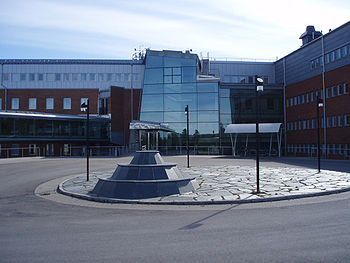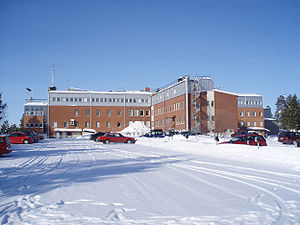
Swedish Institute of Space Physics
Encyclopedia

Sweden
Sweden , officially the Kingdom of Sweden , is a Nordic country on the Scandinavian Peninsula in Northern Europe. Sweden borders with Norway and Finland and is connected to Denmark by a bridge-tunnel across the Öresund....
government agency. The institute's primary task is to carry out basic research, education and associated observatory activities in space physics, space technology and atmospheric physics.
Foundation
The IRF was founded in 1957 and the first Kiruna-designed satellite experiment was launched in 1968. The institute has about one hundred employees and has its head office in KirunaKiruna
Kiruna is the northernmost city in Sweden, situated in Lapland province, with 18,154 inhabitants in 2005. It is the seat of Kiruna Municipality Kiruna (Northern Sami: Giron, Finnish: Kiiruna) is the northernmost city in Sweden, situated in Lapland province, with 18,154 inhabitants in 2005. It is...
. Other offices are situated in Umeå
Umeå
- Transport :The road infrastructure in Umeå is well-developed, with two European highways passing through the city. About 4 km from the city centre is the Umeå City Airport...
, Uppsala
Uppsala
- Economy :Today Uppsala is well established in medical research and recognized for its leading position in biotechnology.*Abbott Medical Optics *GE Healthcare*Pfizer *Phadia, an offshoot of Pharmacia*Fresenius*Q-Med...
and Lund
Lund
-Main sights:During the 12th and 13th centuries, when the town was the seat of the archbishop, many churches and monasteries were built. At its peak, Lund had 27 churches, but most of them were demolished as result of the Reformation in 1536. Several medieval buildings remain, including Lund...
.
IRF, originally the Kiruna Geophysical Observatory, began as a department within the Royal Swedish Academy of Sciences. It has been a public research institute since 1973, under the auspices of the Swedish Ministry of Education and Culture.
Satellite experiments

Solar wind
The solar wind is a stream of charged particles ejected from the upper atmosphere of the Sun. It mostly consists of electrons and protons with energies usually between 1.5 and 10 keV. The stream of particles varies in temperature and speed over time...
and around comet
Comet
A comet is an icy small Solar System body that, when close enough to the Sun, displays a visible coma and sometimes also a tail. These phenomena are both due to the effects of solar radiation and the solar wind upon the nucleus of the comet...
s and planet
Planet
A planet is a celestial body orbiting a star or stellar remnant that is massive enough to be rounded by its own gravity, is not massive enough to cause thermonuclear fusion, and has cleared its neighbouring region of planetesimals.The term planet is ancient, with ties to history, science,...
s. For example, the Swedish Viking
Viking (satellite)
Viking was Sweden's first satellite. It was launched on an Ariane 1 rocket as a piggyback payload together with the French satellite SPOT 1, on February 22, 1986. Operations ended on May 12, 1987...
and Freja
Freja (satellite)
FREJA was a Swedish satellite developed by the Swedish Space Corporation on behalf of the Swedish National Space Board. It was piggyback launched on a Long March 2C launch vehicle from Jiuquan Satellite Launch Center in China on October 6, 1992. The satellite total cost was 19 million U.S...
satellites, with equipment from IRF on board, have greatly increased our knowledge of the auroral processes in the Earth’s magnetosphere, as have the micro-satellites Astrid 1 and 2
Astrid (satellites)
Astrid-1 and Astrid-2 were two microsatellites designed and developed by Swedish Space Corporation on behalf of the Swedish National Space Board. They were piggyback launched on a Cosmos-3M launch vehicle from Plesetsk, Russia...
, launched in 1995 and 1998. IRF's own nano-satellite Munin
Munin (satellite)
Munin was a Swedish nanosatellite. It was launched on November 21, 2000 on a Delta II rocket from the Vandenberg Air Force Base in California, together with two other satellites. Munin was developed by the Swedish Institute of Space Physics in cooperation with students from Luleå University of...
(at 6 kg (13 lb) the smallest-ever research satellite) was launched in 2000. An IRF-built instrument on board the Indian satellite Chandrayaan-1 (launched 2008) collected data from the moon and new techniques for making particle measurements in space were tested on the Swedish satellite mission Prisma (launched 2010). IRF has instruments on board the following on-going satellite projects:
- Cassini (launched 1997), a combined NASANASAThe National Aeronautics and Space Administration is the agency of the United States government that is responsible for the nation's civilian space program and for aeronautics and aerospace research...
/ESA (European Space AgencyEuropean Space AgencyThe European Space Agency , established in 1975, is an intergovernmental organisation dedicated to the exploration of space, currently with 18 member states...
) mission to Saturn and its moon Titan, - ClusterCluster missionCluster II is a space mission of the European Space Agency, with NASA participation, to study the Earth's magnetosphere over the course of an entire solar cycle. The mission is composed of four identical spacecraft flying in a tetrahedral formation...
(2000) is an ESA project with 4 satellites in formation to study the Earth's magnetosphereMagnetosphereA magnetosphere is formed when a stream of charged particles, such as the solar wind, interacts with and is deflected by the intrinsic magnetic field of a planet or similar body. Earth is surrounded by a magnetosphere, as are the other planets with intrinsic magnetic fields: Mercury, Jupiter,...
, - Mars ExpressMars ExpressMars Express is a space exploration mission being conducted by the European Space Agency . The Mars Express mission is exploring the planet Mars, and is the first planetary mission attempted by the agency. "Express" originally referred to the speed and efficiency with which the spacecraft was...
(2003) is an ESA mission to study Mars - Rosetta (2004) is one of ESA's cornerstone projects, and is on its way to a comet,
- Venus ExpressVenus ExpressVenus Express is the first Venus exploration mission of the European Space Agency. Launched in November 2005, it arrived at Venus in April 2006 and has been continuously sending back science data from its polar orbit around Venus. Equipped with seven science instruments, the main objective of the...
(2005) is an ESA satellite to study VenusVenusVenus is the second planet from the Sun, orbiting it every 224.7 Earth days. The planet is named after Venus, the Roman goddess of love and beauty. After the Moon, it is the brightest natural object in the night sky, reaching an apparent magnitude of −4.6, bright enough to cast shadows...
.
Continuous measurements
Continuous measurements of the following are made at IRF- the magnetic field of the Earth
- aurora
- cosmic radio noise
- ionospheric parameters
Ground-based auroral research
Experiments are conducted with research radars, such as those of the European Incoherent Scatter Scientific Association (EISCAT)EISCAT
EISCAT is an acronym for the European Incoherent Scatter Scientific Association. It operates three incoherent scatter radar systems, at 224 MHz, 931 MHz in Northern Scandinavia and one at 500 MHz on Svalbard, used to study the interaction between the Sun and the Earth as revealed by disturbances in...
with transmitters in Tromsø
Tromsø
Tromsø is a city and municipality in Troms county, Norway. The administrative centre of the municipality is the city of Tromsø.Tromsø city is the ninth largest urban area in Norway by population, and the seventh largest city in Norway by population...
and on Svalbard
Svalbard
Svalbard is an archipelago in the Arctic, constituting the northernmost part of Norway. It is located north of mainland Europe, midway between mainland Norway and the North Pole. The group of islands range from 74° to 81° north latitude , and from 10° to 35° east longitude. Spitsbergen is the...
. These are used for example to study the processes which cause the aurora. The three-dimensional structure of the aurora is studied with ALIS (Auroral Large Imaging System), a multi-station imaging system which uses tomographic reconstruction
Tomographic reconstruction
The mathematical basis for tomographic imaging was laid down by Johann Radon. It is applied in computed tomography to obtain cross-sectional images of patients...
techniques, artificial intelligence and advanced IT.
Atmospheric research
Atmospheric research at IRF focuses on studies of- ozoneOzoneOzone , or trioxygen, is a triatomic molecule, consisting of three oxygen atoms. It is an allotrope of oxygen that is much less stable than the diatomic allotrope...
in the stratosphereStratosphereThe stratosphere is the second major layer of Earth's atmosphere, just above the troposphere, and below the mesosphere. It is stratified in temperature, with warmer layers higher up and cooler layers farther down. This is in contrast to the troposphere near the Earth's surface, which is cooler... - strato- and mesospheric clouds
- strato- and mesospheric winds
- coupling between different atmospheric layers (e.g. transport between troposphere and stratosphere) - propagation of mechanical waves
Radar, optical methods, sounding rockets and balloons are used for atmospheric studies. Continuous measurements are made of:
- atmospheric trace gases (including ozone)
- atmospheric winds
- infrasonic waves.
See also
- MuninMunin (satellite)Munin was a Swedish nanosatellite. It was launched on November 21, 2000 on a Delta II rocket from the Vandenberg Air Force Base in California, together with two other satellites. Munin was developed by the Swedish Institute of Space Physics in cooperation with students from Luleå University of...
- Swedish National Space BoardSwedish National Space BoardThe Swedish National Space Board is a Swedish government agency operating under the Swedish Ministry of Education and Science. SNSB distributes government grants to research and development, initiates research and development in space and remote sensing, and is the Swedish contact in international...
- Swedish Space CorporationSwedish Space CorporationThe Swedish Space Corporation is a comprehensive space company covering the entire field, from the definition of innovative business concepts and space projects to the development, tests and operation of the systems....
- EsrangeEsrangeEsrange Space Center is a rocket range and research centre located outside the town of Kiruna in northern Sweden. It is a base for scientific research with high altitude balloons, investigation of the aurora borealis, sounding rocket launches, and satellite tracking, among other things...
- European Space AgencyEuropean Space AgencyThe European Space Agency , established in 1975, is an intergovernmental organisation dedicated to the exploration of space, currently with 18 member states...
- Government agencies in SwedenGovernment agencies in SwedenThe Government agencies in Sweden are state controlled organizations who act independently to carry out the policies of the Swedish Government. The Government Ministries are relatively small and merely policy-making organizations, allowed to control agencies by policy decisions but not by direct...
External links
- Swedish Institute of Space Physics - Official site

